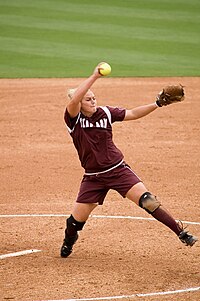
Photo from wikipedia
Background: Single-leg squat (SLS) performance is related to altered mechanics related to injury during the windmill softball pitch; however, it is unknown if SLS kinematics differ between softball pitchers with… Click to show full abstract
Background: Single-leg squat (SLS) performance is related to altered mechanics related to injury during the windmill softball pitch; however, it is unknown if SLS kinematics differ between softball pitchers with and without upper extremity pain. Purpose/Hypothesis: The purpose of this study was to compare knee valgus, trunk rotation, trunk lateral flexion, and trunk flexion during an SLS in collegiate softball pitchers with and without self-reported upper extremity pain. It was hypothesized that those who reported upper extremity pain would show increased compensatory trunk and knee kinematics compared with those without pain. Study Design: Controlled laboratory study. Methods: A total of 75 collegiate softball players (mean age, 20.4 ± 1.7 years; mean height, 173.3 ± 7.7 cm; mean weight, 79.1 ± 11.6 kg) participated and were placed in pain (n = 20) or no-pain (n = 55) groups. Participants performed an SLS once per side. Kinematic data were collected at 100 Hz using an electromagnetic tracking system. A 2 (pain vs no pain) × 2 (descent vs ascent) × 2 (drive leg vs stride leg) mixed-design multivariate analysis of variance with Wilks lambda distribution was used to determine differences in drive-leg and stride-leg lower body mechanics between the descent and ascent phases of the SLS between the pitchers in the current study with and without pain. Results: There was no significant effect in the 3-way interaction between upper extremity pain, side, and phase (Λ = 0.960; F[4, 70] = 0.726; P = .577; η2 = 0.04). However, there were large effects for the phase × side interaction (Λ = 0.850; P = .021; η2 = 0.150). There was a main effect of phase (Λ = 0.283; P < .001; η2 = 0.717). Conclusion: Study findings indicated that SLS mechanics do not differ between collegiate softball pitchers with and without reported upper extremity pain. Drive-leg mechanics showed more stability in the SLS than stride-leg mechanics. Clinical Relevance: Softball pitchers are at risk of upper extremity injury. It is important to identify mechanisms that may lead to pain in order to mitigate the risk of injury.
Journal Title: Orthopaedic Journal of Sports Medicine
Year Published: 2023
Link to full text (if available)
Share on Social Media: Sign Up to like & get
recommendations!